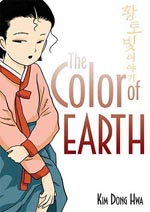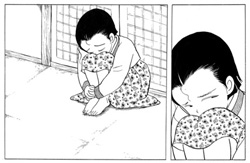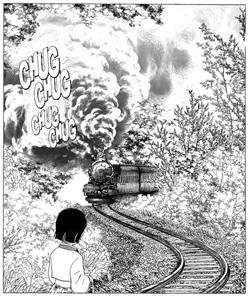 By Kim Dong Hwa
By Kim Dong Hwa
320 pages, black and white
Published by First Second Books
When the manga boom first really erupted into North America, a lot of publishers began also translating Korean comics (or manhwa) into English. One of the big benefits was that manhwa already is read left-to-right, so it didn’t have to go through the whole issue of "flipping" versus reading right-to-left. These days very little manhwa is being translated as the boom has settled back down into a more reasonable level, but occasionally a new manhwa shows up, like Kim Dong Hwa’s The Color of Earth. I think most people would agree that it’s books like The Color of Earth that are a good reminder why ignoring manhwa would cut us off from a whole wealth of really good comics.
Ehwa is a young girl growing up in Korea with her widowed mother. Even as Ehwa tries to understand the crass comments from the people who come to their inn, to her own body itself, big changes are ahead in her life. Boys are just around the corner, not only for Ehwa but for her mother as well. But it’s this arrival of the opposite sex that will ultimately bring Ehwa and her mother even closer together.
 Kim’s The Color of Earth is based in part on his own mother’s early life, although it’s hard to say how many moments are actual events versus fictionalized versions of the full story. As a storyteller, though, Kim takes a leisurely path through a lot of Ehwa’s early life. It felt like Kim was carefully setting down building blocks, not only for The Color of Earth but the other two volumes ahead (The Color of Water and The Color of Heaven). Ehwa does a lot of learning about both her own body as well as women’s bodies in general in the first half of the book; it was hard to not make comparisons in my head to all the Judy Blume books I read when I was younger. It’s in this first half that my attention was much more focused on the story of Ehwa’s mother and her continuing romance with a traveling salesman. I’m glad Kim introduced this element earlier, because for people who aren’t as taken by Ehwa’s journey of self-discovery, it’s a welcome diversion and story to keep one’s attention.
Kim’s The Color of Earth is based in part on his own mother’s early life, although it’s hard to say how many moments are actual events versus fictionalized versions of the full story. As a storyteller, though, Kim takes a leisurely path through a lot of Ehwa’s early life. It felt like Kim was carefully setting down building blocks, not only for The Color of Earth but the other two volumes ahead (The Color of Water and The Color of Heaven). Ehwa does a lot of learning about both her own body as well as women’s bodies in general in the first half of the book; it was hard to not make comparisons in my head to all the Judy Blume books I read when I was younger. It’s in this first half that my attention was much more focused on the story of Ehwa’s mother and her continuing romance with a traveling salesman. I’m glad Kim introduced this element earlier, because for people who aren’t as taken by Ehwa’s journey of self-discovery, it’s a welcome diversion and story to keep one’s attention.
 That said, once the second half of The Color of Earth rolls around, things definitely begin to pick up. Ehwa being less naive and clueless makes for a more interesting story, and not merely because she’s a little more worldly. Her infatuations with two different men are intriguing, especially because both are in many ways out of bounds for Ehwa but for very different reasons. It’s hard to call her emotions at this point as being little more than infatuation, mind you; Kim is careful to give Ehwa very little actual interaction with either of them. It’s a great depiction of a young crush, and how something that feels like it’s so huge and overwhelming is in many ways just a drop in the bucket for things to come. Kim brings Ehwa through this stage of her life in a graceful and interesting manner, even as leaving you curious as to what will happen as she grows older.
That said, once the second half of The Color of Earth rolls around, things definitely begin to pick up. Ehwa being less naive and clueless makes for a more interesting story, and not merely because she’s a little more worldly. Her infatuations with two different men are intriguing, especially because both are in many ways out of bounds for Ehwa but for very different reasons. It’s hard to call her emotions at this point as being little more than infatuation, mind you; Kim is careful to give Ehwa very little actual interaction with either of them. It’s a great depiction of a young crush, and how something that feels like it’s so huge and overwhelming is in many ways just a drop in the bucket for things to come. Kim brings Ehwa through this stage of her life in a graceful and interesting manner, even as leaving you curious as to what will happen as she grows older.
The Color of Earth‘s art is interesting, because while Kim shows strong talent in drawing his characters, it’s actually the least favorite part of the book for me. Don’t get me wrong, I think he does a good job with drawing people in The Color of Earth. Scenes like the sad Ehwa balled up in the corner do a fine job with body language, showing her despair in a way that doesn’t require any additional dialogue or captions to explain what’s going on. But for me, the real attraction of The Color of Earth‘s art is how Kim draws the landscape of Korea. From big knotted trees to grassy meadows full of flowers, every time characters head outside of the town itself I couldn’t help but get excited because I wanted to see just what Kim would draw next. Looking at illustrations of a narrow bridge with moss covering its surface, or of the train winding through the countryside, it’s hard to not feel like Kim has transported you to a different place in time. And really, that’s The Color of Earth‘s ultimate power, to make you feel like you’re with Ehwa and everyone else in the earlier days of Korea.
There’s a lot to love about The Color of Earth. Some of the attractions are the smaller bits, like the ongoing saga of two of the regular patrons of the inn, or the strong relationship between Ehwa and her mother as Ehwa grows older and the two begin to have much more in common. First Second Books’s translated books normally come from Europe, but it’s easy to see why they were taken by Kim’s comics and wanted to bring them into English as well. The Color of Earth brings you to a different time, and with two more volumes ahead you’ll definitely want to extend your stay.
Purchase Link: Amazon.com
